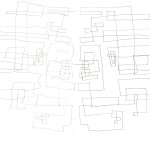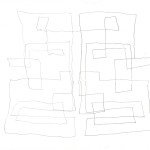Josh Lopez-Binder, Algorithmic Drawing, Assignment 03
Here were my instructions:
Read all instructions and definitions before you start drawing.
Definitions:
RoughHorizontal line: any line within 15 degrees (plus or minus) of true horizontal(0 or 180)
RoughVertical line: any line within 15 degrees (plus or minus) of true vertical (90 or 270)
LocallyPerpendicular: if you magnified the area where two curves or lines intersect, they would appear to be perpendicular.
Instructions:
1) Fold paper in half, unfold. This crease will act as the line about which the figure is mirrored, like rorschach print.
2) with a pencil in each hand, start two lines at one point somewhere along the crease.
3) start drawing two RoughHorizontal lines, the right hand pencil extending a line to the right, the left hand pen to the left
4) at anytime begin the following, with both hands simultaneously, so as to make a symmetrical figure about the crease:
without lifting the pencil:
–make smooth transitions to alternately RoughVertical and RoughHorizontal lines.
–intersect the growing line with older portions of the line so that they are locally perpendicular
–attempt to always intersect older portions of the line before you have made 5 transitions (changes in direction
–do this until you feel you have come to the end: then stop.
Results:
While the instructions were completed correctly for all 3 cases, I was hoping for more organic shapes. The Rough horizontal and vertical definitions were supposed to allow people to draw lines that were not parallel to either edge of the page. Also the instruction to make smooth transitions between horizontal and vertical lines was intended to give the drawing a curvy, organic look. This effect was produced in one instance, but clearly I should have been more exact or perhaps used a better phrase, like “curved transition between lines” or simply stated that the figure should look rather loopy and soft. Anyway the drawings came out nice.



Nice work. Significant diversity in the responses. You’re right, small changes to the language might have produced very different results.